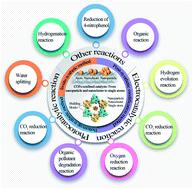当前位置:
X-MOL 学术
›
J. Mater. Chem. A
›
论文详情
Our official English website, www.x-mol.net, welcomes your feedback! (Note: you will need to create a separate account there.)
COF-confined catalysts: from nanoparticles and nanoclusters to single atoms
Journal of Materials Chemistry A ( IF 11.9 ) Pub Date : 2021-09-21 , DOI: 10.1039/d1ta04439g Mengyi Xu 1, 2 , Cui Lai 1, 2 , Xigui Liu 1, 2 , Bisheng Li 1, 2 , Mingming Zhang 1, 2 , Fuhang Xu 1, 2 , Shiyu Liu 1, 2 , Ling Li 1, 2 , Lei Qin 1, 2 , Huan Yi 1, 2 , Yukui Fu 1, 2
Journal of Materials Chemistry A ( IF 11.9 ) Pub Date : 2021-09-21 , DOI: 10.1039/d1ta04439g Mengyi Xu 1, 2 , Cui Lai 1, 2 , Xigui Liu 1, 2 , Bisheng Li 1, 2 , Mingming Zhang 1, 2 , Fuhang Xu 1, 2 , Shiyu Liu 1, 2 , Ling Li 1, 2 , Lei Qin 1, 2 , Huan Yi 1, 2 , Yukui Fu 1, 2
Affiliation

|
In heterogeneous catalytic reactions, nano-scale particles (nanoparticles, nanoclusters, and single atoms) display excellent performance due to their different electronic structures, particle sizes, and geometric shapes. However, nano-scale particles are easy to aggregate and inactivate, so confining nano-scale particles in crystalline porous materials is a best way to solve the above problems. Covalent–organic frameworks with high crystallinity, high porosity, and tunable structures will be a potential alternative, and have attracted substantial attention. More importantly, the interaction between nano-scale particles and supports (confinement effect) could be controlled through different synthetic methods. The confinement effect has a great influence on the performance of the catalysts, for example, the size effect for activity promotion, encapsulation effect for stability enhancement, and molecular-sieving effect for selectivity improvement. Therefore, the confinement effect of COF-confined catalysts provides functional sites for catalytic reactions. There has been a major breakthrough in solving the problems of environmental pollution and energy shortage. The efficiency of heterogeneous catalytic reactions such as hydrogen production, carbon dioxide reduction reaction, 4-nitrophenol reduction, hydrogenation reaction, and organic pollutant degradation has been improved by using COF-confined catalysts. Herein, the synthetic methods of nano-scale particles confined in COFs are summarized, and the interaction between nano-scale particles and COFs is discussed to understand their various confinement effects. Then, the interaction between nano-scale particles and the reactant was understood through heterogeneous catalytic reactions. Finally, perspectives on the future developments in COF-confined catalysts in various fields are highlighted.
中文翻译:

COF 限制的催化剂:从纳米颗粒和纳米团簇到单原子
在非均相催化反应中,纳米级粒子(纳米粒子、纳米团簇和单原子)由于其不同的电子结构、粒径和几何形状而表现出优异的性能。然而,纳米级粒子容易聚集和失活,因此将纳米级粒子限制在结晶多孔材料中是解决上述问题的最佳途径。具有高结晶度、高孔隙率和可调结构的共价有机骨架将是一种潜在的替代方案,并引起了广泛关注。更重要的是,纳米级颗粒与载体之间的相互作用(限制效应)可以通过不同的合成方法进行控制。限制效应对催化剂的性能有很大影响,例如活性促进的尺寸效应,增强稳定性的包封效应和提高选择性的分子筛效应。因此,COF 限制催化剂的限制效应为催化反应提供了功能位点。解决环境污染和能源短缺问题取得重大突破。使用COF限域催化剂提高了制氢、二氧化碳还原反应、4-硝基苯酚还原、加氢反应和有机污染物降解等多相催化反应的效率。在此,总结了限制在 COFs 中的纳米级粒子的合成方法,并讨论了纳米级粒子与 COFs 之间的相互作用,以了解它们的各种限制效应。然后,通过非均相催化反应了解纳米级颗粒与反应物之间的相互作用。最后,强调了对 COF 限制催化剂在各个领域的未来发展的看法。
更新日期:2021-10-27
中文翻译:

COF 限制的催化剂:从纳米颗粒和纳米团簇到单原子
在非均相催化反应中,纳米级粒子(纳米粒子、纳米团簇和单原子)由于其不同的电子结构、粒径和几何形状而表现出优异的性能。然而,纳米级粒子容易聚集和失活,因此将纳米级粒子限制在结晶多孔材料中是解决上述问题的最佳途径。具有高结晶度、高孔隙率和可调结构的共价有机骨架将是一种潜在的替代方案,并引起了广泛关注。更重要的是,纳米级颗粒与载体之间的相互作用(限制效应)可以通过不同的合成方法进行控制。限制效应对催化剂的性能有很大影响,例如活性促进的尺寸效应,增强稳定性的包封效应和提高选择性的分子筛效应。因此,COF 限制催化剂的限制效应为催化反应提供了功能位点。解决环境污染和能源短缺问题取得重大突破。使用COF限域催化剂提高了制氢、二氧化碳还原反应、4-硝基苯酚还原、加氢反应和有机污染物降解等多相催化反应的效率。在此,总结了限制在 COFs 中的纳米级粒子的合成方法,并讨论了纳米级粒子与 COFs 之间的相互作用,以了解它们的各种限制效应。然后,通过非均相催化反应了解纳米级颗粒与反应物之间的相互作用。最后,强调了对 COF 限制催化剂在各个领域的未来发展的看法。



























 京公网安备 11010802027423号
京公网安备 11010802027423号